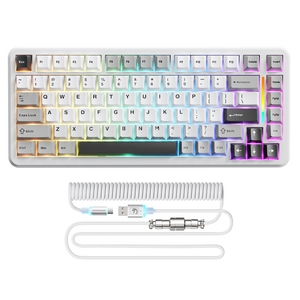
Competitive matches reward clean input under pressure. A dependable gaming keyboard captures each press in the order it happens. Missed jumps, failed reloads, and broken combos often trace back to how a matrix scans and reports keys. N-Key Rollover fixes this by registering simultaneous inputs accurately. With a true NKRO keyboard, movement, modifiers, and skills work together without surprises. This guide explains key ghosting, clarifies USB behavior, compares 6 key rollover with full NKRO, shows how to test a gaming keyboard, and gives a simple buying checklist.
Key Ghosting 101: What Actually Goes Wrong
Most keyboards arrange switches in a grid of rows and columns. The controller scans that grid rapidly. Certain three-key and four-key combinations can confuse the scan. Two patterns appear most often:
- Ghosting: the device reports a key that was never pressed.
- Blocking or masking: a pressed key never reaches the game.
A quick check reveals the issue. Hold W A S D on your gaming keyboard, then add other keys one by one. If some keys stop registering in specific clusters, the matrix is hitting a limit in those routes. Ghosting and blocking come from scanning and reporting constraints. They differ from network or engine latency, which lives outside the keyboard. Once you understand this separation, the value of an NKRO keyboard becomes obvious because it addresses the limit at its source.

What an NKRO Keyboard Really Means on USB
Key rollover describes how many simultaneous keys the device can report correctly. N-Key Rollover means each switch is scanned independently and can be reported together with any others. That is the target for a performance gaming keyboard.
USB often gets blamed for six key limits. Here is the accurate picture. The HID boot protocol uses a compact report designed for firmware and basic input screens. It carries up to six non-modifier keys plus modifiers. Modern operating systems use the standard HID report protocol, which supports larger bitmaps and allows reporting beyond six keys. Engineers achieve USB NKRO with extended reports or composite interfaces. The approach can differ by model; the outcome is the same when done correctly: a gaming keyboard on USB can deliver full NKRO.
6KRO vs NKRO at a glance
| Feature | 6 key rollover | N-Key Rollover |
| Simultaneous keys | Up to six plus modifiers in common cases | Any number by design when implemented correctly |
| Typical use | General typing and light gaming | Competitive play and complex input maps |
| Behavior under dense combos | Higher chance of blocking or ghosting | Stable capture across clusters |
| USB feasibility | Native to small fixed reports | Enabled through larger HID reports or composite design |
Decision in plain terms: for casual typing and slower titles, 6KRO can serve. Once play involves layered modifiers, quick inventory work, hotbar bursts, rhythm timing, or dense FPS inputs, the headroom of an NKRO keyboard becomes a clear advantage. USB does not prevent NKRO in desktop environments. Firmware quality, matrix design, and report configuration decide the result of a modern wired gaming keyboard.

Real Game Gains: Where NKRO Pays Off
To see the value of NKRO, look at common game types. Shooters demand constant movement and quick swaps. MMOs rely on packed rotations. Rhythm and fighting titles need precise chords. NKRO supports each of these patterns with stable input.
For FPS Players
Movement keys often stay pressed while you tap jump, crouch, reload, swap weapons, and use utility. A true NKRO keyboard keeps every signal visible during slide jumps, counter-strafe timing, and quick swaps. Inputs stack cleanly, so you avoid blocked keys at critical moments.
For MMORPG Players
Rotations rely on movement plus modifiers and multiple hotbars. A reliable gaming keyboard with NKRO handles these overlaps without dropping inputs. That steadiness preserves uptime windows and keeps interrupts and dispels on time.
For Rhythm and Fighting Fans
Chorded presses and fast confirm stress any matrix. Full rollover on an NKRO keyboard stabilizes multi-key hits and precise links. Late notes and failed cancels appear less often because the firmware captures what your hands actually do.
How to Test Your Gaming Keyboard for NKRO
Claims are easy to verify at home. Two short methods cover both theory and practice.
- Use an online key visualization test: Open a visual key map. Hold W A S D, then add other keys. The screen shows recognized keys and the count of simultaneous presses. Change clusters and note any missing or phantom keys. This gives a quick view of rollover on your gaming keyboard.
- Run a structured manual pattern: Press and hold two or three alphanumeric keys. While holding them, tap Shift, Ctrl, and Alt in different orders. A well-designed NKRO keyboard should register each added key. This maps strong and weak areas in your specific layout.
How to Read the Results
- If missing keys appear in several clusters during three key chords, your device likely reaches a rollover limit.
- If the tester shows a key that you did not press during two key holds, that is ghosting.
- If behavior changes between pre-boot screens and the desktop, retest after enabling the extended report mode or NKRO setting, then confirm results on the same gaming keyboard layout.
These steps show real capability without special equipment. They also help you compare a current board with a new NKRO keyboard before switching.

Buying Checklist: Choose the Right NKRO Keyboard Quickly
Match features to play style and desk space. The aim is to find a good gaming keyboard that feels immediate and predictable.
- Rollover mode: Confirm NKRO in the specification or manual. Look for an option that enables full reporting on USB. An NKRO keyboard should expose high rollover inside the operating system without extra drivers.
- Matrix and firmware quality: Diode isolation at each switch reduces phantom paths. Stable firmware maintains clean reports during long sessions. After setup, repeat the key test to verify that your gaming keyboard behaves consistently.
- Connection and polling: A wired link removes battery and radio variables. High and steady polling on the host side improves timing. NKRO plus strong polling makes a gaming keyboard feel crisp when multiple keys overlap.
- Switch feel and actuation control: If fast actuation matters, consider switches with adjustable trigger points or magnetic sensing. Faster reset helps with micro adjustments in shooters and tighter windows in rhythm games.
- Layout and size: Tenkeyless frees mouse space for low sensitivity. A full layout helps with macros. Pick a format that keeps your common combos inside strong clusters. The best NKRO keyboard is the one you can control without stretching.
- Software behavior: Check that layers and macros do not alter modifier handling in ways that reduce rollover. Clean defaults protect NKRO benefits during matches.
MAMBASNAKE M82 HE Hall Effect Magnetic Switch 75% Rapid Trigger Gaming Keyboard with 8KHz RGB Coiled Cable
Stop Ghosting with an NKRO Keyboard
Ghosting and blocking come from how a matrix scans and how the device reports keys. The cure is higher rollover with dependable scanning. A true NKRO keyboard captures every press, even when actions stack under pressure. Start with a hands-on test, review your actual input patterns, then select a gaming keyboard that provides NKRO, a stable connection, and actuation control that fits your goals. Choose hardware that mirrors your hands, then practice. With an NKRO keyboard, your inputs stop fighting the matrix and start showing up exactly as intended.



